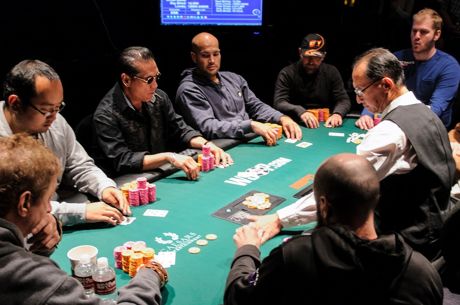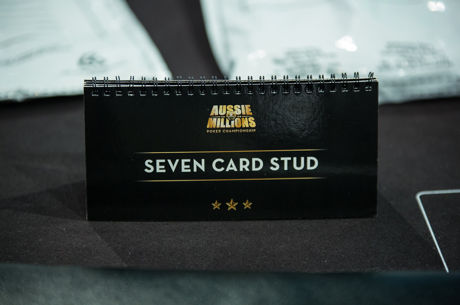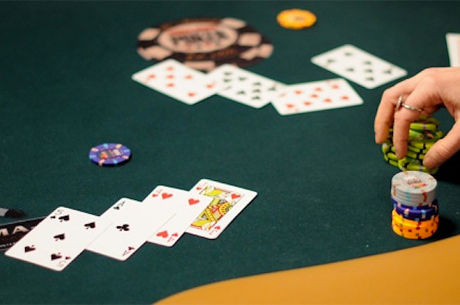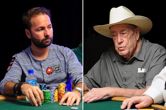Fighting Fire With Fire in WSOP Tournaments (and High-Ante Cash Games)
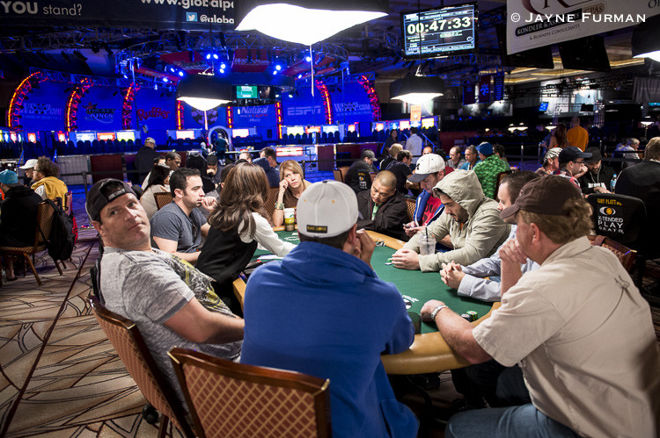
In my last few columns I explored the need for aggression in WSOP tournaments and high-stakes stud cash games — that is to say, stud games with big antes and bring-ins that create a large ratio of pot size to initial bet size.
I concluded that in these games the successful player needs to adopt aggressive tactics not typically used in the low- and mid-stakes games often found in poker rooms. In this column we'll look at what to do when facing opponents who have themselves adopted those same aggressive tactics against you.
Your better opponents will often be very aggressive in WSOP tournaments. They know what you know — that it's necessary to knock people out of pots. The strategy of betting aggressively on third street only when holding the hand you judge to be the best hand just won't succeed when the antes and bring-ins are so high. Your stack will swiftly dwindle to nothing, and you will be exploitable by those who notice your ultra-tight ways.
So what do you do? You have to fight back with aggression of your own — fighting fire with fire, so to speak.
Here's an example:
It's early in the tournament. You have a very strong, aggressive, seemingly experienced player on your right. You've noticed he has won a few uncontested pots, and that his frequency of raising and reraising, successful as it has been in winning him those pots, is at a rate that is greater than that of random distribution of high value starting hands would likely have it be. You conclude that he is mixing in quite a bit of bluffing and/or semi-bluffing.
Up until now you have stayed out of his way. When he's been aggressive, you have folded your borderline hands as well as the weaker hands you would have folded even without his aggression. The two times you had a truly strong starting hand, he wasn't involved. Both times you raised and the pot was conceded to you, once on third street and once on fourth street when you initiated the betting.
A hand arises in which you're dealt (6♥K♦) / A♥. Your strong opponent on your right is showing the Q♠.
You look around the table and see the following up cards and action:
Seat 1: J♠
Seat 2: K♥
Seat 3: 4♣ — brings it in for $50
Seat 4: 7♠ — folds
Seat 5: 5♦ — folds
Seat 6: Q♠ — raises to $100
Seat 7 (You): (6♥K♦) / A♥
Seat 8: 7♥
The action is on you. What do you do with your A♥ showing?
You really don't have much of a hand. Ace-king is not nearly the strong hand in stud that it is in hold'em. It's really just a little better than a completely trash hand on third street, and would be discarded if being considered only for its relative value here as a starting hand.
But as is often the case in stud, a hand's value is in how you might represent it based on your image, your position, and its appearance.
With all of those factors in mind you should often raise in this situation. The initial raiser is known to be very aggressive and may well have raised as a bluff with his queen showing, representing a pair of queens and expecting that neither you nor the exposed king has a pair.
Your image is surely that of a tight player, as you have rarely been in a hand, and the few times that you were you ended up winning in a showdown with the strongest hand. Your raise is likely to be respected.
Also worth considering is that your hand has some legitimate strength and may improve to what would likely be the strongest hand on the next card. Though one of your kings is dead, you still have five cards that would give you a pair better than queens, just in case your raising opponent actually did start with a pair.
Now imagine another scenario. Imagine that your hand and the raising hand are reversed — that he raises with the A♥ showing before it is your turn to act. You look down and see (Q♦2♣) / Q♠. Now what do you do?
Once again, if this were a more typical low-stakes game with a very small pot to fight over, you might well be inclined to fold here rather than compete holding what you'd gauge to be at best the second-best hand.
But in this situation, with a pair of queens against an opponent who has shown himself to be hyper-aggressive, even though you have a hand that might be obviously behind if your opponent has the pair of aces he's representing, your reraise is almost requisite since the possibility that he's bluffing is so great and the pot you're fighting over is so relatively large. Similarly, you don't want to invite in anyone else to make a similar move or even to tag along with a call. So you're reraise is especially important here.
Similar situations come up on later streets, especially fifth street when the bet amounts double. In this example, the bets would go from $100 to $200. Imagine if the hand progressed as follows.
On third street, in spite of your reraise, the K♥ called and the Q♠ did also.
On fourth street none of you obviously improve. You led the betting with your ace-high board and got called by both opponents. On fifth street you saw the following:
Seat 2: K♥3♥7♣
Seat 6: Q♠4♦4♣
Seat 7 (You:): (6♥K♦) / A♥10♠6♦
Your aggressive opponent paired his fourth street card and is now in the lead. Meanwhile you have paired your six, and so now have a pair with an ace-kicker (though you've been representing a pair of aces since third street). He starts the betting for $200 and it's your turn to act. He is representing that he has hit queens up. What do you do?
You might be tempted to call. You could still hit cards that would give you the lead. You surely don't want to fold given the size of the pot, engorged as it is with your third street raise and the three-way action on third on fourth street.
But you shouldn't call. You should raise.
You should raise here to drive out, if possible, the third player. And you should raise here because it need not cost you any more in the long run than calling. If your raise doesn't knock out your opponent it will almost surely get him to check on sixth street, concerned that you have improved to a hand better than his. When he does this you can check behind if you haven't hit either a king, ace or six (in which case you'd surely bet). This will save you a bet.
Alternately, if you read your opponent for weakness on fifth street, you can continue with your semi-bluff and bet after your opponent checks, hoping to win yourself the pot right there. If your bet gets your opponent to fold on sixth street, even a relatively small percentage of the time, it will be worthwhile, given the pot that has been built both by your raises and the participation of the third player for the first two streets.
As a final note, just keep in mind that the good players you are up against in a WSOP tournament or a high-stakes stud game are very likely to remember your aggression. The more aggressive you are, the less your aggression will be respected as the session progresses. So don't go overboard, lest you increase your cost without increasing your chances of winning.
Ashley Adams has been playing poker for 50 years and writing about it since 2000. He is the author of hundreds of articles and two books, Winning 7-Card Stud (Kensington 2003) and Winning No-Limit Hold'em (Lighthouse 2012). He is also the host of poker radio show House of Cards. See www.houseofcardsradio.com for broadcast times, stations, and podcasts.

